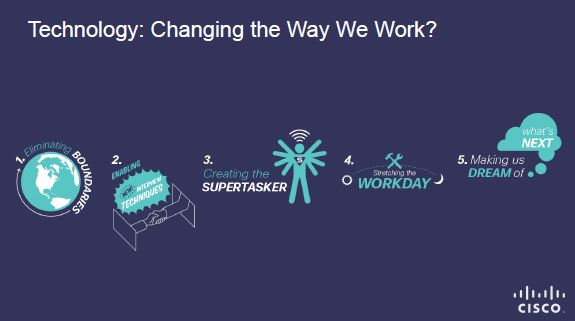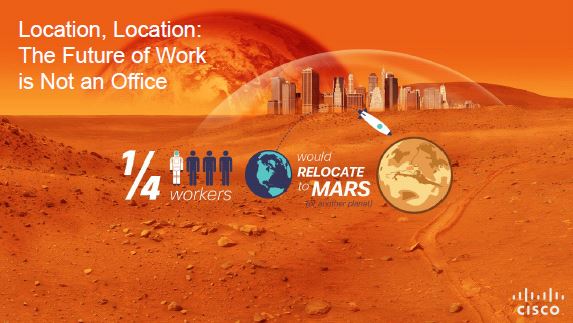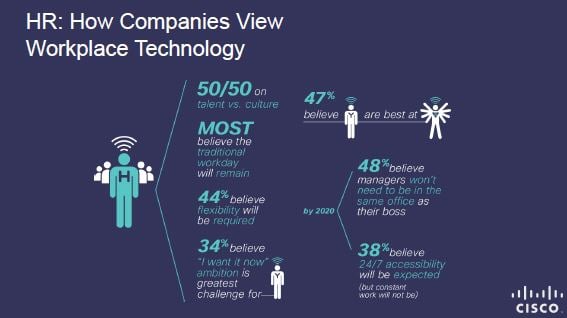Cisco likes to do research and make some calculated guesses as to what it all means. Their annual update of looking at workers and the future of the workplace, Cisco Connected World Technology (CCWTR), provides interesting insights about the changing nature of work as Gen Y and Gen X become the predominant members of the workforce globally.
As Cisco notes, “As in previous years, the CCWTR shows the mindset, expectations, and behavior of the world's next generation of workers, this year with added insights into Gen X and Human Resources workers, and how they value their connectivity (over physical needs), view their availability for work communications (24/7) and how these quirks shape enterprise IT and security policy, product development and design, and the ability of businesses to compete.”
Spoiler alert, there are some surprises and some humorous observations worth thinking about.
The report breaks down into a look at six key trends which are categorized as follows:

(click to enlarge)
The CCWTR is the result of a survey of more than 2,000 people across 15 countries. As noted, its focus is on Gen Y, Gen X along with HR white-collar employees. It sought to find answers to the impact on the future of work from this digitally adept group regarding how the ubiquitous use of mobile devices and communications tools is resulting in expectations from workers to be able to transition these technologies into the workplace.
The goal was straight forward, i.e., answer the question, “How will this technology influence the future workplace and how we work?”
Without embellishment, and referencing some of that whimsy cited above, below are the key findings from this latest iteration with some of the supporting graphics:
Technology Use in the Office: Devices
- Similar to the CCWR in 2012, the 2014 data shows that Gen Y is still very connected to their technology:

(click to enlarge)
- 76 percent choose a smartphone over TV
- They are nearly split on taking sense of smell (58 percent) over Internet access (42 percent)
- 54 percent look at their smartphone first before anything else in the morning
- 45 percent would give carrier access to all personal information for a free smartphone with free data
- 22 percent of Gen Y and 17 percent of Gen X professionals would be most concerned about losing their smartphone during a robbery
- If a brain implant made the World Wide Web instantly accessible, 26 percent of Gen Y and 21 percent of Gen X professionals would have the surgery
- 48 percent would sacrifice sex for one month rather than sacrifice their smartphone
- Cisco sees these Gen Y values carrying over into the workplace.
- Attachment to personal, especially mobile, technology is carrying into the workplace more and more:
- The majority of Gen X and Gen Y professionals use 2-3 devices per day
- 53 percent of both Gen X and Gen Y workers prefer smartphones to desk phones
- 40 percent of Gen Y and 34 percent of Gen X workers believe that by 2020 the smartphone will be the most important device
- The death of the laptop? Has this been a huge exaggeration?
- 7 in 10 HR professionals think Gen Y employees are able to perform tasks faster if they are allowed to use their mobile devices and apps instead of desktop, laptop or notebook PC’s.
- But, 40 percent of respondents would still choose a laptop over another device for work
- The smartphone is overwhelmingly the second-rated choice (34 percent Gen Y; 27 percent Gen X)
- Is Gen Y really the virtual, app generation?
- 63 percent use a pen and paper to take notes during a meeting vs. 13 percent using a smartphone
- The largest proportion (39 percent) of Gen Y professionals who use a technology-driven device to take notes indicate doing so using Microsoft Word, distantly followed by Google Docs (13 percent). Only 8 percent use Evernote.
- What is the reality of application use at work?
- About half of those surveyed have 20 or more personal applications, while the vast majority (92 percent) indicate having less than 20 work related apps. Further, nearly 7 in 10 use less than 10 apps (work & personal) regularly each day.
- Key differences come out in the Gen Y to Gen X comparison: the number of Gen X workers with 60-99 apps on their smartphones is more than double the number of Gen Y workers who have downloaded that many apps.
Technology: Changing the Way We Work?
- Top 5 Ways Technology is Changing the Way You Work:

(click to enlarge)
- Eliminating Boundaries: the influx of smart, mobile devices into the workplace seems to have reset expectations on where and how work should happen
- Supporting stat (see below): 27 percent of Gen Y workers surveyed would relocate to Mars if their company opened a branch.
- Enabling New Interview Techniques: with workers more willing to explore opportunity wherever it arises – even in a galaxy far, far away – those in charge of hiring feel the same way and want talent wherever it comes from.
- 58 percent of HR workers surveyed would hire a candidate without ever meeting face-to-face and relying solely on video interaction
- Creating the “Supertasker:” access to multiple smart devices (on average, 2-3 per person) has enabled workers to work anytime, anywhere and be available 24/7.
- About half of Gen X and Gen Y professionals believe Supertasking would make an individual more productive. Similarly, HR professionals (62 percent) predominantly believe Supertaskers increase their organization’s productivity.
- HR professionals feel that Supertaskers increase the expectations of a “high performer” at their organization and as such, most feel Supertaskers are best suited for a job.
- Stretching the Workday: the greater flexibility allowed by technology has also changed the 9-to-5 workday, with many workers and HR professionals moving toward flexible scheduling, remote working capabilities and always-on work communication.
- More than half of professionals consider themselves accessible for work 24 hours a day, 7 days a week, including 3 in 10 who are accessible by both email and phone.
- While salary is the most important factor for most in their decision to accept a position, the flexibility to set their own schedule or the ability to work remotely is most important to roughly 1 in 5 Gen X and Gen Y professionals, as well as one third of HR professionals.
- Making us Dream of What’s Next: in the few years that smartphones went from a bring-your-own-device hot topic to an everyday norm, we are optimistic about the future technology offers for our work lives.
- Roughly 8 in 10 professionals believe middle income workers will have robots that can assist them with various work related activities – although most do not expect such robots to be available by the year 2020.
- Assuming a company invented a brain implant that made the World Wide Web instantly accessible, roughly one quarter would move forward with the operation – Gen Y professionals (26 percent) slightly more so than Gen X (21 percent).
Location, Location: The Future of Work is Not an Office

(click to enlarge)
- About 45 percent of workers want the freedom to work and play from anywhere, at anytime, with no restrictions (vs. 9 –5 workday).
- Most Gen X professionals believe Gen Y employees would prefer a flexible work schedule, though Gen Y professionals are split. 25 percent of Gen Y workers currently work for an organization that allows flexible working. Roughly one third (34 percent) enjoy working from home because it saves time on the commute.
- The largest proportion of Gen Y professionals (44 percent) indicate being more focused and productive when working in the office, while Gen X professionals (38 percent) cite being equally focused and productive both at home and in the office.
Supertasking: The New Normal?

(click to enlarge)
- Gen X (42 percent) and Gen Y (44 percent) professionals, as well as nearly 6 in 10 (58 percent) HR professionals consider themselves Supertaskers.
- Among Supertaskers, the largest proportion cite Supertasking best on a smartphone (43 percent Gen Y and 37 percent Gen X)
- When Supertasking, the majority typically mix work and personal activities, particularly Gen X professionals (70 percent).
- HR professionals (62 percent) predominantly believe Supertaskers increase their organization’s productivity. Most feel Supertaskers are best suited for a managerial, an individual contributor or an executive role.
- Additionally, nearly two thirds of HR (62 percent) believe in the year 2020, Supertasking will be most coveted by their organization.
HR: How companies View Workplace Technology

(click to enlarge)
- Most professionals believe that middle income workers will have robots to assist them (i.e. scheduling, coordination, project management, technical support, etc.) sometime in the future; among them, 7 in 10 believe it may not happen in 2020 but maybe by 2030.
- 58 percent of HR professionals would be willing to hire someone without meeting the candidate in person and by holding interviews remotely via a video conference.
- Interestingly, while those in India, Australia and Brazil are very open to the idea of hiring someone without meeting them in person, those in Japan are far less willing (only 16 percent).
The bottom line of all of this is most apparent in the final graphic above. The digitally adept who will be populating the workplace understand that connectivity and the rapid introduction of innovation will be constants in their lives. As a result, the workplace will become more dispersed/virtual and the nature of work will change—including the addition of new tools like robots—and employer expectations about availability will continue to make work/life balancing a challenge.
The flip side of the last point is that a fickle workforce in terms of loyalty will expect employer flexibility as to who, what, where, why, how and when work will be done. What it means, which is not in the report, is that the metrics for performance are going to have to change along with the increased virtualization of work. It also means that HR people are going to have a really interesting time in finding the right/best people for a world in constant change. Finding those Supertaskers who can not only supertask but can deal with increased ambiguity on a host of fronts will not be easy. Indeed, that flexibility challenge may be the biggest since the one constant that is reflected in looking back at previous CCWTR’s is that not only is change a fact of life but so is the acceleration of it.
Edited by
Maurice Nagle